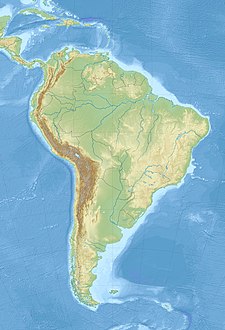Boreostemma
| Boreostemma | |
|---|---|

| |
| Tail ofBoreostemmafrom theHonda Group | |
| Scientific classification | |
| Domain: | Eukaryota |
| Kingdom: | Animalia |
| Phylum: | Chordata |
| Class: | Mammalia |
| Order: | Cingulata |
| Family: | Chlamyphoridae |
| Subfamily: | †Glyptodontinae |
| Genus: | †Boreostemma Carlini et al. 2008 |
| Type species | |
| †Boreostemma pliocena Carlini et al. 2008
| |
| Species | |
| |
Boreostemmais an extinctgenusofglyptodontsfrom northern South America. Fossils assigned to the genus were first described as belonging toAsterostemmafrom southern South America, but have been placed in the new genusBoreostemmaby Carlini et al. in 2008. Thetype speciesisB. pliocena.Fossils ofBoreostemmahave been found in theHonda GroupofColombia,inPeruandVenezuela.
Etymology
[edit]The genus nameBoreostemmais a combination ofstemma,taken fromAsterostemma,andboreois derived fromborealis,meaning "northern", to distinguish the northern South American genus from the southernAsterostemma.[1]
Taxonomy
[edit]Boreostemmahas been placed as closely related to the laterGlyptodonandGlyptotherium.Cladogram after Barasoain et al. 2022:[2]
| Glyptodonts |
| ||||||||||||
Species
[edit]Four species have been described in the genusBoreostemma.[3]UnspecifiedBoreostemmafossils were found in theIpururo Formationof thedepartmentofUcayali,AmazonianPeru.[4][5][6]Asterostemmacontains the type speciesA. depressaand severalnomina dubia.The genus has been found in theEarly Miocene(Santacrucianin theSALMA classification)Santa Cruz Formationof theprovinceofSanta Cruz,Argentinaand in theSolimões Formationin thestateofAcre,AmazonianBrazil.[7][8]
- B. pliocena
Thetype speciesB. pliocenawas described in 2008 by Carlini et al. based on 30 osteoderms palate fragment with M6-7 alveoli.[9]Fossils have been described from thetype localityalong the road to Tío Gregorio in theCodore Formationat theLagerstätteofUrumaco.[10]
- B. gigantea
B. giganteawas described asAsterostemma giganteain 1997 by Carlini et al. based on a partial skeleton.[11]Fossils have been recovered at the Duke Localities 32, 108, 113, 114 and 121W in theLa Victoria Formationof theHonda Groupat theKonzentrat-LagerstätteLa Venta.[12][13][14][15][16]
- B. acostae
B. acostaewas described asAsterostemma acostaein 1983 byCarlos Villarroelbased on a carapace fragment with 44 plates.[17]Fossils have been found in theCerbatana Member,and the Chunchullo Sandstone of theLa Victoria Formation,of theHonda Groupat theKonzentrat-LagerstätteLa Venta.[18][19]
- B. venezolensis
B. venezolensiswas described asAsterostemma venezolensisin 1947 byGeorge Gaylord Simpson,[20]based on most of the carapace and the anterior end of the lower jaw, including teeth.[21]Fossils have been uncovered from theSanta Inés Formationalong the banks of the Güere River in thestateofAnzoáteguiin Venezuela.[22]
Gallery
[edit]See also
[edit]References
[edit]- ^Carlini et al. 2008,p. 142.
- ^Barasoain, Daniel; Zurita, Alfredo E.; Croft, Darin A.; Montalvo, Claudia I.; Contreras, Víctor H.; Miño-Boilini, Ángel R.; Tomassini, Rodrigo L. (June 2022)."A New Glyptodont (Xenarthra: Cingulata) from the Late Miocene of Argentina: New Clues About the Oldest Extra-Patagonian Radiation in Southern South America".Journal of Mammalian Evolution.29(2): 263–282.doi:10.1007/s10914-021-09599-w.ISSN1064-7554.S2CID245945029.
- ^BoreostemmaatFossilworks.org
- ^IN-DTC-28atFossilworks.org
- ^IN-DTC-32atFossilworks.org
- ^IN007atFossilworks.org
- ^Cañadón Jack, Yak-HarveyatFossilworks.org
- ^Rio AcreatFossilworks.org
- ^Boreostemma pliocenaatFossilworks.org
- ^Road to Tio Gregorio LocalityatFossilworks.org
- ^Boreostemma giganteaatFossilworks.org
- ^Duke Locality 32atFossilworks.org
- ^Duke Locality 108atFossilworks.org
- ^Duke Locality 113atFossilworks.org
- ^Duke Locality 114atFossilworks.org
- ^Duke Locality 121WatFossilworks.org
- ^Boreostemma acostaeatFossilworks.org
- ^Arcillas San NicolasatFossilworks.org
- ^Chunchullo SandstoneatFossilworks.org
- ^Simpson, 1947, p.2
- ^Boreostemma venezolensisatFossilworks.org
- ^Banks of the Güere RiveratFossilworks.org
Bibliography
[edit]- Carlini, Alfredo A.; Zurita, Alfredo E.; Scillato Yané, Gustavo J.; Sánchez, Rodolfo; Aguilera, Orangel A. (2008),"New Glyptodont from the Codore Formation (Pliocene), Falcón State, Venezuela, its relationship with theAsterostemmaproblem and the paleobiogeography of the Glyptodontinae ",Paläontologische Zeitschrift,82(2): 139–152,Bibcode:2008PalZ...82..139C,doi:10.1007/BF02988405,retrieved2017-09-26
- González Ruiz, Laureano R.; Ciancio, Martin R.; Martin, Gabriel M.; Zurita, Alfredo E. (2014),"First record of supernumerary teeth in Glyptodontidae (Mammalia, Xenarthra, Cingulata)"(PDF),Journal of Vertebrate Paleontology,e885033 (1): 1–6,Bibcode:2015JVPal..35E5033G,doi:10.1080/02724634.2014.885033,retrieved2017-09-26
- González, Laureano Raul (2010),Los Cingulata (Mammalia, Xenarthra) del Mioceno Temprano y Medio de Patagonia (edades Santacrucense y "Friasense" ) revisión sistemática y consideraciones bioestratigráficas (PhD thesis),Universidad Nacional de La Plata,pp. 1–468,retrieved2017-09-26
- Simpson,George Gaylord (1947),"A Miocene glyptodont from Venezuela",American Museum Novitates(1368): 1–10,CiteSeerX10.1.1.866.6506,retrieved2018-10-01
- Zurita, Alfredo E.; González Ruiz, Laureano R.; Gómez Cruz, Arley J.; Arenas Mosquera, José E. (2013),"The most complete known Neogene Glyptodontidae (Mammalia, Xenarthra, Cingulata) from northern South America: taxonomic, paleobiogeographic, and phylogenetic implications",Journal of Vertebrate Paleontology,33(3): 696–708,Bibcode:2013JVPal..33..696Z,doi:10.1080/02724634.2013.726677,hdl:11336/2971,retrieved2017-09-26









